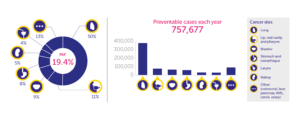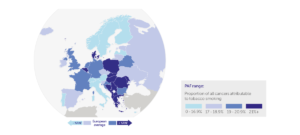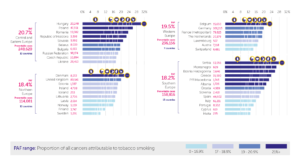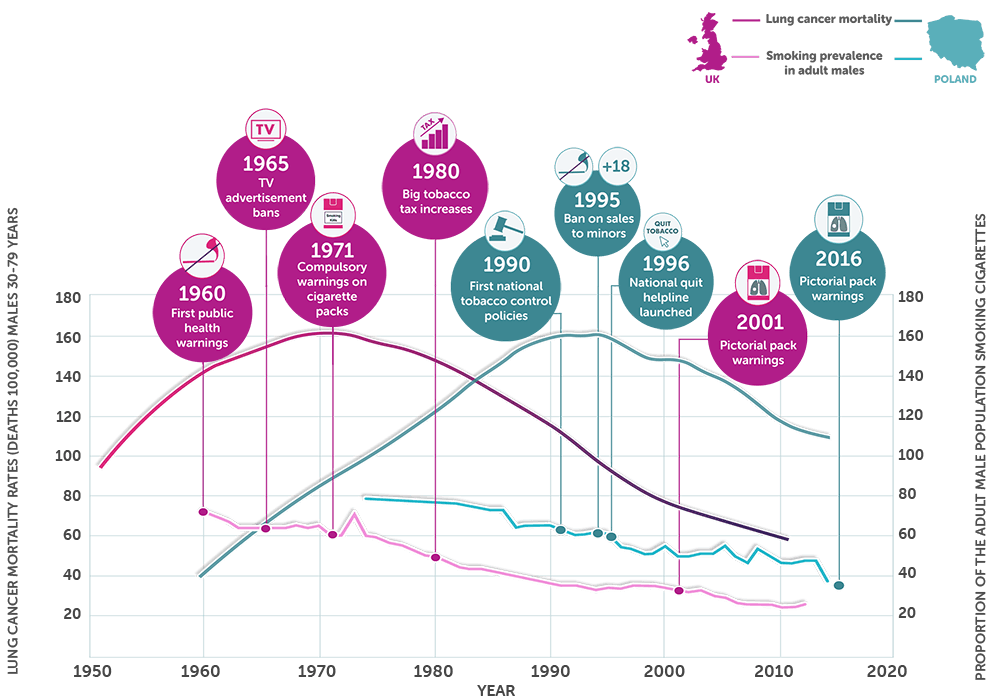Tobacco-related cancers and prevention
Cancers caused by smoking in Europe
Tobacco smoking is the major preventable cause of cancer. It is estimated to be an attributable factor for more than 757 000 cancer cases per year in Europe (1 in 5 cancer cases in Europe in 2018). Implementing tobacco control measures such as the World Health Organization Framework Convention on Tobacco Control (WHO FCTC), enables reductions of the prevalence of tobacco smoking and exposure to tobacco smoke, and consequently decreases the heavy burden of disease and death attributable to this cause.
Proportion of cancer cases that are attributable to tobacco smoking, and number of new cases per year that could be prevented.
Most of the 19.4% of cancer cases in Europe that are attributable to tobacco (population attributable fraction; PAF) are cancers of the lung. Cancers at other sites account for 50% of cancers caused by tobacco smoking in Europe.
Infographics produced in partnership with Cancer Research UK
EUROPE SUMMARY
 Infographics produced in partnership with Cancer Research UK
Infographics produced in partnership with Cancer Research UK
Country summaries
The charts below show, for each country in Europe, the overall percentage of cancers at all specified sites that are attributable to smoking (population attributable fraction; PAF). The PAF uses information on the risks of smoking, the incidence of lung cancer (which was used as a proxy for long-term smoking), and the incidence of cancer in each country to calculate the proportion of cancers that could be avoided if no one smoked. Adjacent to each country name is the estimated number of new cases this represents for 2018.
 Infographics produced in partnership with Cancer Research UK
Infographics produced in partnership with Cancer Research UK
To download the A4 poster, click here.
Thank you to Alice Cotelli and Jon Shelton of Cancer Research UK for designing and producing the figures.
- Kulhánová I, Forman D, Vignat J, Espina C, Brenner H, Storm HH, et al. (2020). Tobacco-related cancers in Europe: the scale of the epidemic in 2018. Eur J Cancer. 139:27-36. https://doi.org/10.1016/j.ejca.2020.07.024 (accessed 20 October 2020)
- Bray F, Ferlay J, Soerjomataram I, Siegel RL, Torre LA, Jemal A (2018). Global cancer statistics 2018: GLOBOCAN estimates of incidence and mortality worldwide for 36 cancers in 185 countries. CA Cancer J Clin. 68(6):394-424. https://doi.org/10.3322/caac.21492 (accessed 20 October 2020)
Lung cancer mortality rates in men
Cancer prevention strategies face challenges in implementation, but the potential gains are striking. The dramatic declines in lung cancer incidence and mortality in many European countries after decreases in the prevalence of smoking are evidence of the power of successful prevention.
Lung cancer mortality and smoking prevalence in the UK (1950–2013) and Poland (1960–2013) and selected tobacco control interventions in the two countries

This figure shows that the mortality rate for lung cancer in men aged 30–79 years in the UK peaked in the early 1970s at about 160 per 100 000 per year and has since declined dramatically. In contrast, the lung cancer mortality rate in men in Poland only peaked two decades later; this can be partly attributed to the later commencement of the effective prevention of tobacco exposure through national control policy measures. In the UK, the first TV advertisement bans and health warnings on cigarette packs appeared in the early 1960s. In Poland, such initial measures were not taken until the late 1980s.
SourcesThank you to Morena Sarzo of the International Agency for Research on Cancer (IARC/WHO) for designing and producing the figures.
- IARC cancer mortality database, WHO Mortality Database (2016). Available from: http://www-dep.iarc.fr/WHOdb/WHOdb.htm (accessed 4 January 2018).
- Cancer Research UK. Tobacco statistics. Available from: http://www.cancerresearchuk.org/healthprofessional/cancer-statistics/risk/tobacco#ref-3 (accessed 4 January 2018).
- Zatoński WA, Przewoźniak K, Sulkowska U, Mańczuk M, Gumkowski J (2009). Palenie tytoniu w populacji mężczyzn i kobiet w Polsce w latach 1974-2004. Zeszyty Naukowe Ochrony Zdrowia, Zdrowie Publiczne i Zarządzanie. VII(2):4–11 [in Polish].
- Berridge V, Loughlin K (2005). Smoking and the new health education in Britain 1950–1970s. Am J Public Health. 95(6):956–964.
- Jassem J, Przewozniak K, Zatonski W (2014). Tobacco control in Poland-successes and challenges. Transl Lung Cancer Res. 3(5):280–285.

